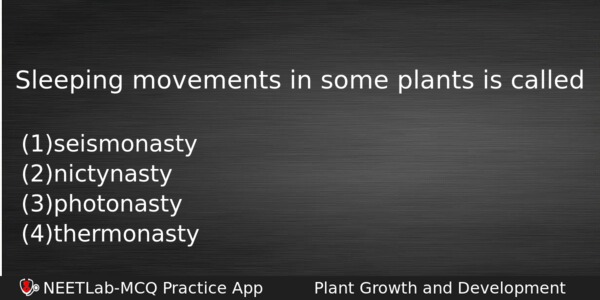| ⇦ | 
| ⇨ |
Sleeping movements in some plants is called
Options
(a) seismonasty
(b) nictynasty
(c) photonasty
(d) thermonasty
Correct Answer:
nictynasty
Explanation:
Sleep movement or nyctinasty (sleep movement during night) occurs in the leaves of many legumes and Oxallis is due to turgor changes in response to darkness. The leaves fold at night but open during the day. Leaves of Mimosa pudica also show sleep movement, called as seismonasty (shock movement) in response to physical contact, injury, electric current etc. The movement occurs due to osmotic changes.
Related Questions: - Most of the tree dwellers are found in which type of forest?
- Glycolysis consists of
- Which one of the following is not an essential mineral element for plants
- The plants face wilting due to use of excessive fertilizers because of
- Salamanders unlike othr can reproduce in their larval stages and show neoteny
Topics: Plant Growth and Development
(126)
Subject: Biology
(4253)
Important MCQs Based on Medical Entrance Examinations To Improve Your NEET Score
- Most of the tree dwellers are found in which type of forest?
- Glycolysis consists of
- Which one of the following is not an essential mineral element for plants
- The plants face wilting due to use of excessive fertilizers because of
- Salamanders unlike othr can reproduce in their larval stages and show neoteny
Topics: Plant Growth and Development (126)
Subject: Biology (4253)
Important MCQs Based on Medical Entrance Examinations To Improve Your NEET Score
18000+ students are using NEETLab to improve their score. What about you?
Solve Previous Year MCQs, Mock Tests, Topicwise Practice Tests, Identify Weak Topics, Formula Flash cards and much more is available in NEETLab Android App to improve your NEET score.
Share this page with your friends

Leave a Reply